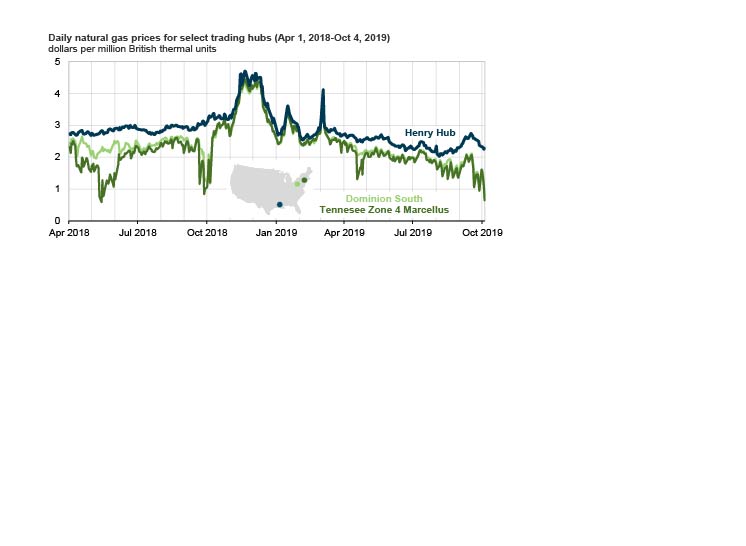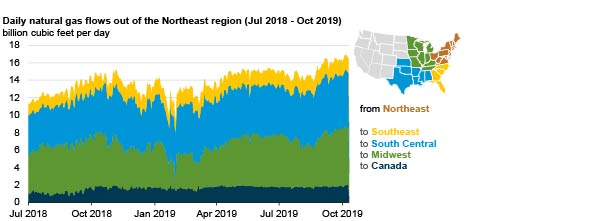
Natural gas flows out of the Northeast region into the rest of the United States averaged more than 16 billion cubic feet per day (Bcf/d) during September—between 1 Bcf/d and 2 Bcf/d more than in previous months, according to data from Genscape. The movement of natural gas has increased as natural gas spot prices have declined in the Northeast and as production in Appalachia has continued to grow.
During the past three weeks, natural gas prices at Appalachian supply hubs, Dominion South and Tennessee Zone 4 Marcellus, fell from about $2 per million British thermal units (MMBtu) in mid-September to lows of 76¢/MMBtu and 65¢/MMBtu, respectively, on October 4. The resulting average price difference of $1.59/MMBtu lower than the Henry Hub national benchmark was the widest price gap since October 5, 2018. In both instances, Northeastern pipelines had declared force majeure—a declaration used when unforeseeable events prevent companies from fulfilling their contractual obligations.
Lower prices in recent weeks have resulted in more favorable economics for transporting natural gas volumes from the Northeast to other regional demand markets, notably those in the South Central and Midwest regions. Natural gas spot prices in southwestern Pennsylvania, at Dominion South, and in northeastern Pennsylvania, at Tennessee Zone 4 Marcellus, typically averaged 20¢/MMBtu to 50¢/MMBtu lower than Henry Hub prices this spring and summer, and this discount began to widen in August.
In September, the average natural gas spot prices at these hubs was 83¢/MMBtu lower than the Henry Hub average, and the difference to Henry Hub widened to an average of $1.59/MMBtu lower on October 4. Similarly, the price gap between Appalachian Basin natural gas spot prices and those at the Chicago Citygate widened from 20¢/MMBtu earlier in 2019 to 94¢/MMBtu on October 4.

Flows from the Northeast into Midwest demand markets have grown primarily because of increased use of the Rover and Rockies Express pipelines. Increased flows on these pipelines coincided with an explosion on the Texas Eastern Transmission (TETCO) pipeline (1.7 Bcf/d capacity) on August 1, which forced rerouting of southbound TETCO flows of natural gas out of the Northeast onto other pipelines. However, volumes delivered to the Midwest have continued to rise despite TETCO returning to partial service in late August.
The explosion on the TETCO system limited southbound capacity out of the Northeast, but flows from the Northeast through the Midwest region to South Central demand markets have increased. Southbound flows on the Tennessee Gas Pipeline (TGP) and Columbia Gulf Pipeline (TCO) were flowing at or near full capacity for most of September, according to Genscape.


Follow us on social media: